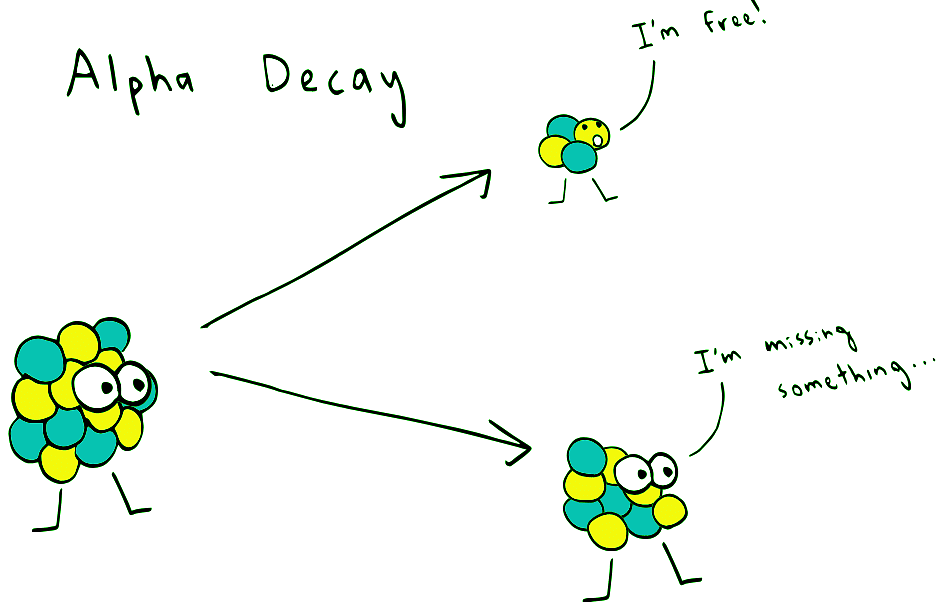A Journey into Radioactive Decay Types | General Chemistry for MCAT PDF Download
| Table of contents |

|
| Introduction |

|
| The Essence of Nuclear Reactions |

|
| Unraveling the Types of Nuclear Reactions |

|
| Unlocking the Secrets of Nuclear Decay |

|
| Conclusion |

|
Introduction
The universe is full of secrets, and one of its most enigmatic phenomena is nuclear reactions. Atoms, the building blocks of matter, sometimes undergo mysterious transformations, turning into completely different atoms without any warning. These awe-inspiring processes, known as nuclear reactions, involve changes in the nucleus of an atom, altering its composition and properties. In this captivating article, we will delve into the intriguing world of nuclear reactions, understanding their types, the release of radiation, and the astonishing randomness that characterizes these transformations.
The Essence of Nuclear Reactions
Unveiling the Nature of Nuclear Reactions
Atoms, much like humans, can exhibit discontent with their current state. Nuclear reactions occur when an atom's nucleus experiences a change in the number of protons and neutrons it contains. Similar to how chemical reactions cause compounds to transform by exchanging electrons, nuclear reactions result in the alteration of an atom's nucleus.
The Alchemical Nature of Nuclear Reactions
In a manner reminiscent of alchemy, nuclear reactions can transform an atom from one element to another. By referencing the atomic number on the periodic table, which corresponds to the number of protons, we identify an element. Thus, when the atomic number changes, so does the element's name. Astonishingly, this metamorphosis occurs without any conspicuous signs, except for the release of radiation, a topic we will explore further.
The Element of Randomness in Nuclear Reactions
One of the most bewildering aspects of nuclear reactions is their tendency to occur randomly. Even if we know that a particular nucleus will eventually decay, the exact moment of decay remains unpredictable. Observing a nucleus could take seconds or an entire lifetime before witnessing its sudden transformation. Nevertheless, by studying multiple nuclei simultaneously, scientists can determine the average time it takes for decay to occur. While the average decay time is measurable, the precise timing remains entirely arbitrary.
Unraveling the Types of Nuclear Reactions
Alpha Decay: A Particle Breakup
Alpha decay involves the disintegration of a nucleus into two components: an alpha particle, comprising two protons and two neutrons, and the remaining nucleus. This type of decay is illustrated by the following chemical equation:
- Ra → Rn + He²⁺

Beta Decay: The Shifting Protons
Beta decay occurs when a neutron within the nucleus transforms into a proton, leading to an increase in the atomic number. The alteration in the number of protons subsequently changes the element itself. An example of beta decay is the transformation of potassium-40 into calcium-40:
- K → Ca + e⁻ + ν

Gamma Decay: Energetic Radiation
During gamma decay, the nucleus emits radiation while its composition remains unchanged. As the nucleus rearranges itself to a lower energy state, it emits a high-energy photon known as a gamma ray. Gamma radiation possesses immense energy and poses a significant risk to living tissues, capable of passing through most barriers. However, gamma decay also finds practical applications, such as in medical imaging techniques.

Unlocking the Secrets of Nuclear Decay
The Nature of Isotopes
Atoms of the same element can have different masses due to varying numbers of neutrons. These different versions of an element are called isotopes. Carbon, for instance, has the isotopes carbon-12 and carbon-14, with different numbers of neutrons but the same atomic number. This duality of isotopes affects an element's stability and the type of decay it undergoes.
Radiation Exposure during Long-Term Space Travel
Beyond the realm of nuclear reactions on Earth, space exploration brings us face-to-face with cosmic radiation. Cosmic rays, consisting mainly of high-energy photons or gamma radiation, present a considerable risk to astronauts on long-distance space missions. Without the protective shield of Earth's atmosphere, special measures must be taken to mitigate the harmful effects of cosmic radiation and ensure the safety of future space travelers.
Conclusion
The captivating realm of nuclear reactions offers a glimpse into the extraordinary transformations atoms can undergo. From the mysterious nature of these reactions to the different types of decay, each with its own intriguing characteristics, we have explored the inner workings of atomic metamorphosis. Whether unlocking the secrets of alpha decay, witnessing the shifting protons in beta decay, or encountering the energetic radiation of gamma decay, the wonders of nuclear reactions continue to fascinate and astound us. As we embark on the quest for knowledge and understanding, scientists endeavor to harness the power of these reactions for both medical advancements and the exploration of distant cosmic frontiers.
|
164 videos|11 docs|16 tests
|















